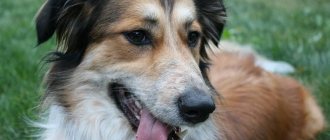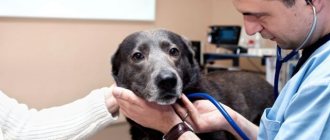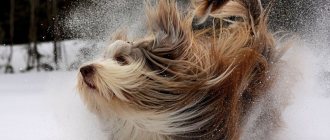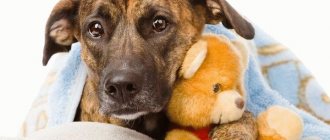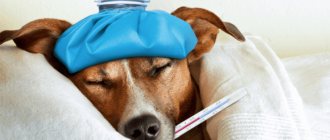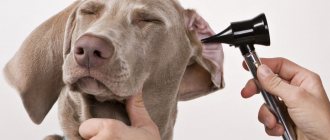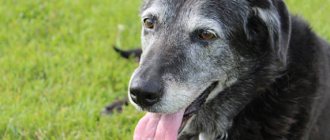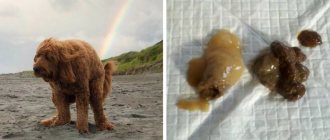Dandruff in dogs is common. Dandruff cannot be classified as a disease, but you should not lose vigilance and forget about veterinarians. Dandruff is not only an unsightly appearance of a dog’s fur and discomfort due to the fact that it itches all the time, you shouldn’t leave everything to chance and try to get rid of it with an affordable specialized shampoo, deciding to do everything intuitively rather than engage in treatment.
If your puppy's skin itches on his back and his hair is falling out, this is a serious reason to think about treating your dog. To do this, you will need the help of a specialist who will tell you what and how to do to get rid of the source of the appearance and prescribe competent treatment.
Dandruff in a dog is a signal to the owner that something has gone wrong in the pet’s body. Renewal of the keratinized epidermis is a natural process; the skin is constantly renewed, shedding dead scales. But with proper functioning of the body, this process occurs unnoticed, unnoticed by the owner.
It is necessary to monitor the condition of the puppy’s coat; dandruff that appears is an alarming sign that signals a problem in the dog’s body.
What is dandruff in a dog?
During cell regeneration, part of the epidermis dies and peels off. This process is accompanied by the formation of small scales resembling fine flour or flakes. If their number gradually increases and affects the quality of the coat, causing baldness and other alarming symptoms, then the pet should be checked for diseases.
What does it look like
Most often, dandruff appears on a dog's back, neck, ears, belly and tail area. It is easy to notice when combing the fur or regular stroking. In addition to the standard white color, 3 more options are possible:
- yellow, accompanying seborrheic dermatitis;
- black, which appears when the functionality of the sebaceous glands is impaired and when blood clots;
- red, characteristic of peeling inflamed skin.
The scales can be dry or greasy to the touch. In the first case, they easily fall off the body, and in the second, they get stuck in the hairs, giving them an unkempt appearance and an unpleasant odor.
What can be confused with
Dying epidermis can be confused with fleas and lice. These parasites have similar sizes, colors and shapes. They can be distinguished due to their mobility.
Small black dots may be traces of coagulated blood that appears at the site of scratches or insect bites. Here it is worth paying attention to the accompanying symptoms. Local hair loss and severe itching are not typical for such cases.
Prevention of the disease
Prevention of dandruff follows from the causes of its occurrence. The most important component is love, care, attention. Pets feel the attitude of their owners towards them on an emotional level, so the owner needs to do everything to provide the animal with psychological comfort. In addition, it is necessary to talk about specific care rules that prevent increased peeling of the epidermis.
- Proper balanced nutrition (if the dog is accustomed to dry food, then it is important for the owner to choose a high-quality, expensive product that does not contain allergens). A natural menu should contain all the necessary vitamins; eating eggs, river fish, and vegetables is considered beneficial. If the owner refuses industrial vitamin supplements, you need to look for alternatives. Dried fruits, seaweed, wheat sprouts, honey (in small quantities), nettle leaves, and flax seeds have a good effect on the dog’s body.
- Compliance with the schedule of hygiene procedures . Firstly, if the breed can get by with two baths a year, there is no need to wash the coat every week, this can help wash out the natural protective layer. Secondly, you need to use only proven products intended for animals; human shampoos are not suitable for dogs. Thirdly, it is important to comb or cut (depending on the type of coat) regularly, especially for long-haired pets. Moreover, the comb is also selected according to the type of cover; it should not harm the skin.
- Timely treatment for ticks and fleas. The main problem of dermatitis is parasite bites, so it is important to carry out antiparasitic procedures, especially in the warm season.
- Cure from infectious diseases and fungi.
- Avoiding stressful situations , frequent walks, communication with your pet.
Dandruff is not a disease, but a symptom. It is impossible to cure a pet of external problems without solving internal problems. Therefore, it is important to contact a veterinarian to find out the main causes of peeling skin.
5 / 5 ( 1 voice )
Causes of skin peeling
A negative reaction from the skin is caused not only by internal pathologies, but also by external factors. Peeling can appear at any time of the year, regardless of the length of the coat and the age of the pet.
Despite this, dandruff in a puppy is often caused by unstable functioning of the sebaceous glands. In the absence of pathologies, it goes away on its own after some time.
External factors
This group includes the negative impact of the external environment, excluding internal violations. It is much easier to eliminate such causes, but if treatment is delayed, they can develop into quite serious diseases.
Stress
Four-legged pets have a hard time withstanding even temporary separation from their owner, so a sudden business trip or trip abroad can provoke a disruption in metabolic processes. Particularly nervous animals include decorative breeds that cannot tolerate noisy sounds or the appearance of new family members.
Prolonged nervous tension weakens the immune system and aggravates chronic pathologies. To eliminate it, you need to get rid of irritating factors and take a course of sedatives.
Poor nutrition
Lack of vitamins and consumption of low-quality feed worsen health, immediately affecting the appearance of the skin. Unfiltered tap water can cause similar problems.
For your pet to recover, it is necessary to reconsider its diet in favor of at least premium food or high-quality natural products. Drying and natural water should not be mixed with each other, and water should always be cleaned of harmful compounds and regularly replaced with fresh water.
Parasites
Itching and peeling are caused by ecto- (living directly on the skin) and endoparasites living in tissues and internal organs. These include fleas, lice eaters, ticks and helminths.
Detachment of the epidermis occurs due to constant scratching or intoxication. The listed parasites often carry pathogens of deadly diseases: piroplasmosis, ehrlichiosis, borreliosis, bartonellosis and tick-borne encephalitis.
Improper care
Skin problems often arise from improper combing, blow-drying at maximum power, using aggressive detergents, neglecting hygienic haircuts, and bathing too rarely or too often. To return to a healthy appearance you need to:
- Change the comb to a softer one.
- Use a hair dryer as little as possible and only at minimum power.
- Purchase veterinary shampoos with hypoallergenic properties.
- Trim excess hair regularly.
- Bath your pet only if it is heavily soiled or before a show.
More detailed information about care can be found in the grooming salon. Here you can undergo most procedures, which is suitable for especially busy owners.
Shedding
During seasonal molting, not only hairs are renewed, but also epidermal cells. In this case, the animal’s condition normalizes on its own after some time. Frequent brushing with a furminator will help facilitate coat renewal.
Allergy
Another possible reason is an allergic reaction. It is caused by flea bites, pollen, certain foods, dust and even sunlight. In addition to itching and peeling, the formation of a rash, swelling and inflammation is noted.
The disease is treated with antihistamines and glucocorticosteroids. In case of food allergies, the practice is to switch to a special diet that excludes the most common allergens.
Dry air
Low humidity is typical for the heating season. Not only four-legged pets suffer from dryness and flaking, but also their owners. The situation can be corrected with the help of a moisturizer and emollient ointments.
Internal factors
Internal pathologies disrupt metabolism, causing a lack of microelements throughout the body. This also affects tissue regeneration, which is why a sick dog develops dandruff.
Infections
This group includes bacterial and fungal infections that cause local hair loss and the formation of bald spots. Breeds with folded skin are at risk. With insufficient care, pathogenic microflora develops quite quickly in these areas, attracted by high humidity and dirt.
Dermatitis
Inflammatory lesions of the skin are characteristic of atopic dermatitis, seborrhea, ichthyosis and sebadenitis. Despite similar symptoms, all these diseases require completely different treatments.
Systemic pathologies
Systemic pathologies include hormonal disorders (hypothyroidism, diabetes mellitus, hypo- and vitamin deficiency), diseases of the urinary system (liver and kidneys) and some gastrointestinal disorders (impaired intestinal absorption). All of them lead to incorrect functioning of the sebaceous glands, intoxication of the body and accumulation of metabolic products in the subcutaneous tissue.
Etiological reasons for the development of seborrhea
There are primary and secondary seborrhea, and they occur with similar clinical symptoms. Primary seborrhea is a hereditary disease and is manifested by a violation of keratinization of the skin. It is most often found in American Cocker Spaniels, English Springer Spaniels, West Highland White Terriers and Basset Hounds, but Irish Setters, Doberman Pinschers, Shar Peis, Dachshunds, Labrador Retrievers and German Shepherds also have an increased risk of developing . Primary seborrhea is detected at an early age and diagnosed using a skin biopsy. With this form of the disease, it is also important to exclude the causes leading to secondary seborrhea.
Secondary seborrhea can be caused by external or internal factors, which leads to disruption of the normal desquamation of superficial skin epithelial cells. Almost any skin disease during its acute phase or recovery period can lead to the development of seborrhea. In general, the mechanisms by which the normal process of keratinization of the skin is disrupted are not completely clear.
It is believed that the inflammatory process on the skin, some endocrine diseases (hyperadrenocortisolism, hypothyroidism), nutritional deficiencies (unbalanced diet, impaired digestion and absorption) and environmental factors (excessive bathing, low humidity) contribute to the development of secondary seborrhea. Diagnosis of seborrhea is simple and based on a characteristic clinical picture; it is much more difficult to determine the cause of its development. The diagnostic approach varies from case to case. In addition to collecting a mandatory medical history, the veterinarian performs a diet analysis, microscopy of skin scrapings and a trichogram (examination of the condition of the hair), excludes intestinal parasites and signs of digestion and absorption disorders in the intestines. When lesions cover most of the skin surface (generalized seborrhea), a skin biopsy is usually not required.
Associated symptoms
In addition to profusely flaking scales, other accompanying symptoms may indicate that your pet is unwell. If they are detected, it is recommended to contact a veterinary clinic as soon as possible.
Severe itching
If your dog has dandruff and constantly itches, biting its teeth into the skin until it bleeds, show it to the doctor. Bloody scratches that appear with intense itching are fraught with secondary infection. If diagnosis is delayed, you will have to deal not only with the root cause, but also with complications.
Sores of various types
In inflamed areas, ulcers, papules, rashes and vesicles may form. Over time, these sores damage deeper and deeper layers, opening the way for pathogenic microorganisms.
Hair loss
Symmetrical loss of tufts of hair is characteristic of hormonal disorders, parasitosis and seborrhea. In the second case, in addition to abundant hair loss, their thinning and a strong unpleasant odor are noted.
Baldness in patches
Patchy baldness is the main symptom of fungal infection. Over time, individual bald spots merge together, worsening the overall picture. If hair loss is associated with an autoimmune disease, then the hairs disappear forever. The hips, sides and groin of the animal are particularly affected.
Pros and cons of the breed
Pros:
- Learning ability. Yorkies must be trained, and not rely on the natural rudiments of consciousness. When walking, Yorkies run the risk of getting caught in the teeth of large dogs. Without knowing the commands, they will not be able to react in time and return to the owner.
- Tray. One of the few breeds that can be litter trained, which is very convenient for very busy owners.
- Hypoallergenic.
- Hands. These animals love and want to be in the arms of their owner. The habit was developed in ancient times and continues to this day. Previously, they were used by aristocratic people with high wigs to catch lice (yes, there were problems with hygiene before).
Minuses:
- Diet. Feeding Yorkies is not like feeding regular dogs and requires careful attention from the owners. The diet is selected individually by a doctor and is often based on expensive dry food.
- Care. Caring for Yorkies requires both money and time. The dog needs to be washed, cut and combed.
- Cloth. Yorkies do not have a hairy undercoat, so they can easily get cold and get sick.
- Tendency to mental disorders. Yorkies need peace at least sometimes. There is no need to take your dog with you on visits or to noisy events. It's better to spend time with him before or after and leave calmly.
Why you should see a veterinarian
If your dog has dandruff, check with your veterinarian about what to do. Due to the wide variability of causes, a number of studies must be completed to make a correct diagnosis:
- blood analysis;
- allergy tests;
- skin scraping;
- Wood's lamp test;
- tests for bacteriological and mycological culture;
- Ultrasound and X-ray.
Self-medication should be avoided, since erroneous diagnosis will only worsen the patient’s condition, complicating the work of doctors. After receiving the test results and collecting an anamnesis, your four-legged pet will be given a treatment based on the cause of its disease.
Causes of dandruff
- Shampoos and hair care products. Everything is like with people - if the means are chosen incorrectly, then the body’s response will definitely follow.
- Diabetes mellitus, hypothyroidism, hyperadrenocorticism - endocrine diseases.
- Hormonal imbalance.
- Allergic reaction to chicken.
- Ticks.
- Allergic reaction to food.
- Water with poor chemical composition. Both for swimming and drinking.
- Stress. Occurs when moving, when waiting for a long time for the owner, for example, from work. Stressful situations also include meeting other dogs. At the same time, the Yorkie can be on a leash or sit in the arms of the owner and desperately bark at the enemy. This dandruff goes away as quickly as it appeared.
- Air. If the indoor air is too dry, it can also affect dry skin. As a rule, this effect is observed in winter, when the batteries in the house are operating at full capacity.
- Unbalanced diet.
As can be seen from the reasons, the virus may not always manifest itself in the form of dandruff. In addition, if the veterinarian does not know what virus it is, but still prescribes antibiotics, it is better to go to another specialist. It definitely won't hurt. The doctor should also order blood tests, urine tests, and skin scrapings. This is how the presence of diabetes mellitus and many other causes is determined. A mysterious virus is not serious at all.
How to get rid of dandruff in a dog
All methods used are aimed at strengthening the immune system, relieving itching and restoring metabolic processes. It is especially important to eliminate all factors that increase the detachment of the epidermis.
Reviewing your diet and adding vitamins
First of all, it is necessary to make changes to the diet, making it more varied and balanced. When feeding naturally, you should control the calorie-protein-fats-carbohydrates (calories-protein-fats-carbohydrates) and be sure to give your pet vitamins. It is almost impossible to get them from food alone.
In ready-made feeds, the norms are already calculated in advance and indicated on the packaging. It is enough for owners to adhere to these recommendations and not skimp on quality by refusing bulk or low-quality pellets.
Treatment of skin diseases
Drug treatment for dandruff in dogs depends on the diagnosis. Depending on the cause, the animal may be prescribed the following medications:
- sedatives that suppress nervous tension;
- antiparasitic, destroying ecto- and endoparasites;
- antihistamines and glucocorticosteroids that suppress allergic reactions;
- antibiotics and antimycotic agents that fight bacteria and fungi;
- anti-inflammatory, necessary to eliminate inflammation;
- immunostimulants and vitamins that strengthen the immune system.
If the reason lies in hormonal imbalance, then the four-legged patient undergoes mandatory castration. After removal of the reproductive organs, hormone levels gradually return to normal.
Shampoos and sprays
To eliminate itching, use Lactaderm, Tropiclin and Doctor shampoos based on tar, salicylic acid and sulfur. They have a calming and softening effect, but quite often cause an allergic reaction. Before use, it is recommended to apply a portion of the product to a small area of skin to ensure that there is no intolerance to the incoming components.
Suitable sprays include Stop Itching, Frontline and Stronghold. The first drug is used to treat any skin pathologies, and the second and third are used to treat parasitosis.
Folk remedies
Some folk remedies can also help cope with excessive peeling, itching and inflammation of the skin. These include:
- sea buckthorn, burdock and olive oils, eliminating the dry type of pathology;
- decoctions of nettle, chamomile and burdock, softening the skin;
- a mixture of essential oils (3-5 drops of lavender, eucalyptus and tea tree per 50 ml of almond oil) that destroys fleas and ticks.
You should consult your veterinarian before using these products. Incorrect dosage can lead to irritation, rashes and other allergic reactions.
Itching Relievers
All antipruritic drugs are divided into fast-acting and slow-acting drugs. The former are suitable for emergency care when the exact diagnosis is not yet known. When using the latter, the result may be absent during the first few weeks, so they are prescribed as a permanent treatment.
In addition to shampoos and sprays, you can purchase drugs in the form of tablets and injection solutions. Here it is better to build on the characteristics of your pet and the recommendations of the veterinarian.
Parasites
You cannot draw conclusions about your pet’s condition without the help of a specialist and ignore the problem, since dandruff in dogs can be associated with the presence of parasites in the animal’s body. One such parasite is the hair mite, a tiny grayish-yellow insect. This creature parasitizes on the surface of the dog's skin, feeding on lymph and tissue fluid. The presence of parasites causes unbearable itching, the puppy is constantly itching, and is dangerous because it is contagious to people and other animals.
The good news is that it is not difficult to rid a dog of a hair mite; the main thing is to identify the disease in time and begin treatment, doing everything to prevent re-infestation - clean the rugs and the animal’s belongings, wash your own things.
Differential diagnosis
First of all, it is necessary to exclude the presence of dermatitis of parasitic or allergic etiology in the dog. To do this, take a skin scraping from the animal or a smear-imprint with adhesive tape. These types of diagnostics make it possible to identify the causative agent of the pathology.
In the case of allergic dermatitis, blood is drawn to identify the allergen.
A stool test is necessary if internal parasites are suspected.
An ultrasound is performed to identify internal pathologies that could trigger the development of dandruff.
Based on the diagnostic results, the veterinarian decides what to do next and what treatment to prescribe for the dog.
